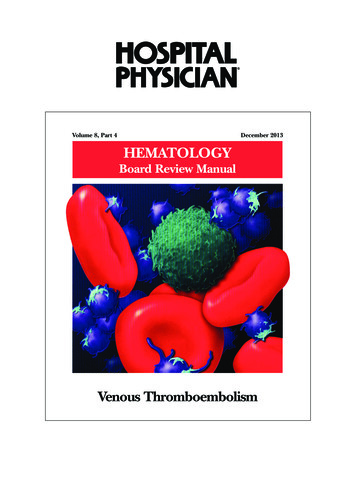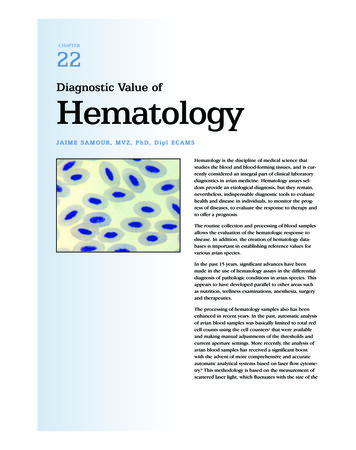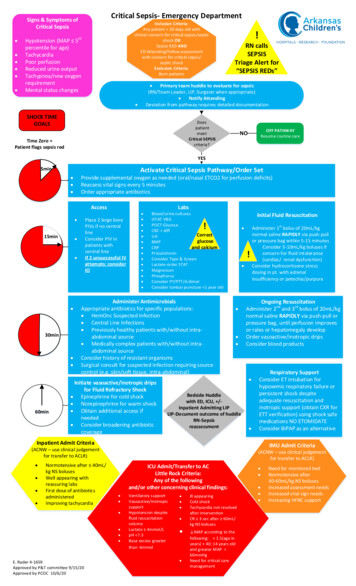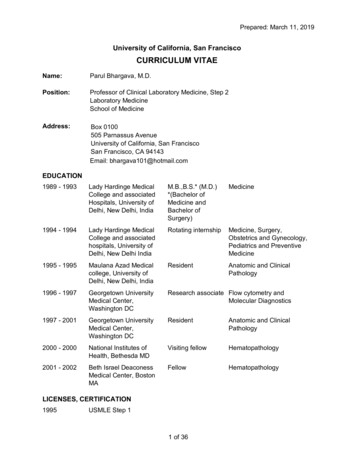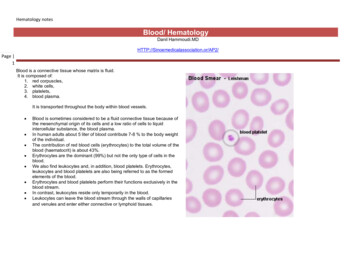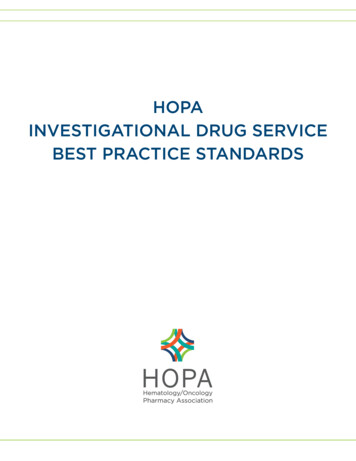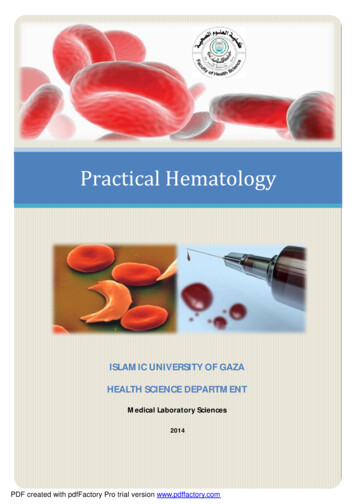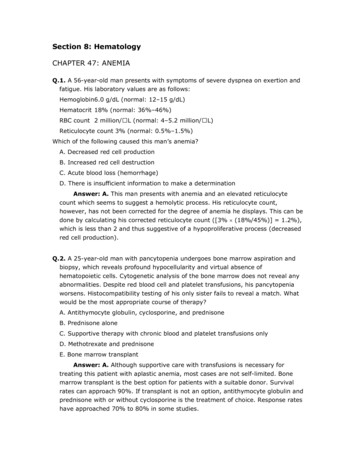
Transcription
Section 8: HematologyCHAPTER 47: ANEMIAQ.1. A 56-year-old man presents with symptoms of severe dyspnea on exertion andfatigue. His laboratory values are as follows:Hemoglobin6.0 g/dL (normal: 12–15 g/dL)Hematocrit 18% (normal: 36%–46%)RBC count 2 million/ L (normal: 4–5.2 million/ L)Reticulocyte count 3% (normal: 0.5%–1.5%)Which of the following caused this man’s anemia?A. Decreased red cell productionB. Increased red cell destructionC. Acute blood loss (hemorrhage)D. There is insufficient information to make a determinationAnswer: A. This man presents with anemia and an elevated reticulocytecount which seems to suggest a hemolytic process. His reticulocyte count,however, has not been corrected for the degree of anemia he displays. This can bedone by calculating his corrected reticulocyte count ([3% (18%/45%)] 1.2%),which is less than 2 and thus suggestive of a hypoproliferative process (decreasedred cell production).Q.2. A 25-year-old man with pancytopenia undergoes bone marrow aspiration andbiopsy, which reveals profound hypocellularity and virtual absence ofhematopoietic cells. Cytogenetic analysis of the bone marrow does not reveal anyabnormalities. Despite red blood cell and platelet transfusions, his pancytopeniaworsens. Histocompatibility testing of his only sister fails to reveal a match. Whatwould be the most appropriate course of therapy?A. Antithymocyte globulin, cyclosporine, and prednisoneB. Prednisone aloneC. Supportive therapy with chronic blood and platelet transfusions onlyD. Methotrexate and prednisoneE. Bone marrow transplantAnswer: A. Although supportive care with transfusions is necessary fortreating this patient with aplastic anemia, most cases are not self-limited. Bonemarrow transplant is the best option for patients with a suitable donor. Survivalrates can approach 90%. If transplant is not an option, antithymocyte globulin andprednisone with or without cyclosporine is the treatment of choice. Response rateshave approached 70% to 80% in some studies.
Q.3. A 60-year-old man presents with abdominal pain, diarrhea, and markedweakness. He notes that his symptoms have been present for a few weeks. He hasa history of monoclonal gammopathy of undetermined significance (MGUS) andulcerative colitis. About one month ago he was treated for bronchitis with a 7-daycourse of trimethoprim/sulfamethoxazole. He does not take any medicationspresently. His review of symptoms is positive for darkening of his urine. Hisphysical examination shows a pulse of 110/min, blood pressure of 130/80, and atemperature of 99.8 F. His sclerae are icteric, and he is pale. His abdomen isdiffusely tender without rebound or guarding. The spleen tip is palpable. His stoolis brown, watery, and hemoccult positive. Laboratory studies are as follows:WBC9000/ LHemoglobin7 g/dLHematocrit 22%MCV: 90 flPlatelets200,000/ LReticulocyte count 12%LDH 500 U/dLTotal bilirubin5 mg/dLDirect bilirubin0.4 mg/dL.His peripheral smear reveals numerous spherocytes. Direct antiglobulin test ispositive with anti-IgG and anti-C3 sera. What is the most appropriate course oftherapy for this patient?A. Blood transfusion of four units over four hoursB. Splenectomy and transfusion (if needed)C. Chlorambucil and transfusion (if needed)D. Steroids and transfusion (if needed)E. Transfusion and supportive care alone, but at a slow rateAnswer: D. This patient has a reticulocytosis, which suggests a hemolyticprocess. The presence of spherocytes on peripheral smear and a positive directantiglobulin test with anti-IgG point to a diagnosis of warm antibody immunehemolytic anemia. Anti-C3 can also be seen in these patients. The initial treatmentfor this form of anemia is steroids. If this treatment fails, splenectomy can beattempted. This patient also has symptoms that could be consistent with ulcerativecolitis. Ulcerative colitis is associated with warm antibody hemolytic anemia.Lymphoproliferative disorders and collagen vascular disease are also associated,although over half of all cases are idiopathic. A is incorrect; blood transfusionsshould be given slowly and only if absolutely necessary. C is incorrect becausechlorambucil is used to treat cold agglutinin hemolytic anemia associated withMGUS. If this patient had cold agglutinin disease, an anti-IgG would not have beenfound; only an anti-C3 would be present.
Q.4. A 70-year-old man with no significant past medical history comes into youroffice for a visit. He is found to have a hemoglobin of 12.9 g/dL (HCT 39%). HisMCV is 92 fl. His red cell distribution width (RDW) is elevated at 17.5%. A reviewof his old records reveals a hemoglobin level of 14.9 g/dL when he last saw adoctor 10 years ago. His creatinine is 0.9 mg/dL. Which of the followingstatements is correct regarding this patient’s condition?A. He will be considered anemic if his hemoglobin falls below 12 g/dLB. An evaluation of the drop in his hemoglobin is unnecessary as this can beexpected with agingC. If his hemoglobin continues to decline, his erythropoietin level should decreaseD. Fetal hemoglobin should make up approximately 1% of the hemoglobin in thiselderly manE. His elevated RDW suggests that there is poikilocytosis (abnormally shaped redblood cells)Answer: D. This patient has anemia, defined by a hemoglobin of less than 13g/dL and his drop in hemoglobin over time. Although many older patients developanemia, it is not a normal function of aging and does require evaluation. Tissuehypoxemia from decreasing hemoglobin is the major stimulus to erythropoietinproduction which results in production of red blood cells by the bone marrow. Anelevated RDW suggests that there is anisocytosis (variation in size of red cells) butsays nothing about the shape. Normal hemoglobin usually consists of about 97%hemoglobin A (α2β2), 2% hemoglobin A2 (α2 2), and 1% hemoglobin F (α2γ2).Q.5. A 72-year-old man with a history of diabetes, hypertension, congestive heartfailure, and mitral regurgitation (s/p MVR) presents to the office complaining offatigue. On examination, his pulse is 68; blood pressure is 115/68. There is noJVD. His lungs are clear. His heart exam reveals a laterally displaced PMI, goodprosthetic sounds, and an I/VI crescendo-decrescendo systolic murmur at the leftsternal border. His labs reveal the following:WBC5,500/µLHematocrit 26Platelets207,000/µLMCV 94 fLCreatinine 0.9 mg/dL.His reticulocyte count is 8%. His PT and PTT are within normal limits. His peripheralsmear is shown in Figure 47Q-1. The most appropriate next step in this patient’smanagement isA. Obtain an echocardiogramB. Perform a bone marrow biopsy
C. Begin steroids and consider plasmapharesisD. Check a glucose-6-phosphate dehydrogenase levelE. Transfuse 2 units of packed red blood cellsAnswer: A. This man presents with anemia and reticulocytosis whichsuggests a hemolytic process. His peripheral smear shows numerous schistocyteswhich is consistent with microangiopathic hemolytic anemia (MAHA). Thedifferential diagnosis of MAHA includes thrombotic thrombocytopenic purpura(TTP), hemolytic-uremic syndrome (HUS), disseminated intravascular coagulation(DIC), malignant hypertension, and prosthetic valvular disease. He does not havefever, thrombocytopenia, neurologic changes, or renal disease so TTP and HUS areunlikely. Also, he does not have malignant hypertension. His coagulation times arenormal so DIC is also unlikely. New MAHA in a patient with a prosthetic valverequires evaluation of the valve with an echocardiogram to ensure that the valveis functioning appropriately. If it is, a decision regarding supportive care with iron(and possibly transfusion) versus valve replacement must be made.Q.6. Patients with anemia of chronic disease usually haveA. A mean corpuscular volume (MCV) of between 80 and 100 flB. An elevated soluble serum transferrin receptor levelC. A low serum ferritinD. An elevate serum iron levelE. A decrease in their erythropoietin levelsAnswer: A. In anemia of chronic disease (ACD), serum iron, total ironbinding capacity, and transferrin saturation levels are usually low. The ferritin isusually normal or high. Soluble serum transferrin receptor levels are elevated iniron deficiency but are normal in pure ACD. There is a blunted erythropoietinresponse in ACD but the rise in level is insufficient to maintain a normalhematocrit. Most cases of ACD are normocytic, despite often being characterizedas a microcytic anemia.Q.7. A 52-year-old man who is complaining of intense fatigue, dyspnea, anddiarrhea of 2 months duration comes to your office. He reports losing about 15pounds over the past few months. He has no past medical history. He reportsdrinking a glass of wine every night. He takes no medications. His physicalexamination reveals pallor and tachycardia to 105 beats per minute. He has ablood pressure of 130/80. You obtain blood work that shows the following:Hemoglobin8.2 g/dLHematocrit25%MCV115 fL
Reticulocyte index1.2Platelets101 K/µLWhich of the following statements is correct?A. The absence of anti-intrinsic factor antibodies would rule out pernicious anemia.B. The normal methylmalonic acid level would essentially rule out folate deficiency.C. If this patient had vitamin B12 deficiency from celiac sprue and malabsorption,the urinary excretion of radiolabeled B12 would be low even after administration oforal intrinsic factor (stage II).D. A peripheral smear in this patient is likely to reveal target cells andschistocytes.E. A bone marrow examination should be done immediately to rule outmyelodysplastic syndrome.Answer: C. This patient presents with a diarrhea and a macrocytic anemia.The differential diagnosis of macrocytic anemia includes vitamin B12 deficiency,folate deficiency, myelodysplastic syndrome, and hypothyroidism. Multiplemyeloma, aplastic anemia, and alcohol abuse can also cause macrocytosis andanemia. With this degree of macrocytosis, vitamin B12 or folate deficiency are themost likely. Intrinsic factor antibodies are specific but not sensitive for perniciousanemia (PA). If they are positive, the diagnosis of PA is virtually assured. In folatedeficient patients with normal renal function, methylmalonic acid levels aretypically normal but homocysteine levels are increased. The diarrhea andmacrocytic anemia suggest the possibility of a malabsorptive process such assprue. If this is the diagnosis the Schilling test is likely to be abnormal even afteradministration of intrinsic factor, because the vitamin B12 deficiency is not due toa deficiency in intrinsic factor. If the Schilling test were repeated after a few weekson a gluten-free diet (stage III) it should be normal. The peripheral smear of thispatient should not show schistocytes, because the low reticulocyte count rules outhemolysis. Given the likelihood of vitamin B12 or folate deficiency with thispresentation, a bone marrow examination does not need to be done at this time.Q.8. Which of the following laboratory findings are not typically seen in a patientwith pernicious anemia?A. Elevated gastrin levelB. Elevated methylmalonic acid levelC. Abnormally low percentage of radiolabeled vitamin B12 excreted after ingestionof oral radioactive vitamin B12 and intrinsic factor with intramuscularadministration of unlabeled vitamin B12 (stage II of the Schilling test)D. Elevated homocysteine levelE. All of the above findings are typically seen
Answer: C. Until recently the Schilling test was the primary way to diagnosepernicious anemia. In stage II of the test, oral intrinsic factor is given with oralradiolabeled vitamin B12 to correct the intrinsic factor deficiency seen in PA.Therefore, the absorption of radiolabeled oral B12 is normalized, as shown by anexcretion level of greater than 7%. Elevated gastrin levels are seen in about 80%of patients with PA. This test, however, lacks specificity. Methylmalonic acid andhomocysteine are metabolites that are both elevated in vitamin B12 deficiency. Anelevated methylmalonic acid level is quite specific for vitamin B12 deficiency.Elevated homocysteine levels, however, are seen in other conditions, includingfolate deficiency.Q.9. A 36-year-old man presents with fatigue and pallor. He is found to have ahematocrit of 23%. His reticulocyte index is 4. You suspect a hemolytic anemia.Which of the following lab abnormalities are not associated with hemolyticanemia?A. An elevated haptoglobin levelB. An elevated LDHC. An elevated indirect bilirubinD. An elevated reticulocyte countE. The presence of hemosiderin in the urineAnswer: A. Patients with hemolytic anemia typically present with an elevatedreticulocyte count, LDH, and indirect bilirubin. Hemosiderin may be present inpatients with intravascular hemolysis. Haptoglobin is a protein that binds freehemoglobin for uptake by the reticuloendothelial system. During hemolyis theamount of free hemoglobin rapidly exceeds the production of haptoglobin, solevels are typically low.Q.10. A 60-year-old man presents with fever, fatigue, headache, and myalgias forthe past 4 days. He recently returned from a vacation on Martha’s Vineyard. Onexamination, his pulse is 110 and his BP is 110/70. His temperature is 39 C. Thereis some scleral icterus. His blood work reveals the following:Hemoglobin8.2 g/dLHematocrit 24%MCV 94 fLReticulocytesPlatelets9%150 K/µLTotal bilirubin3.5 mg/dLDirect bilirubin1 mg/dLLactate dehydrogenase500 U/dL
A peripheral smear is obtained that reveals intraerythrocytic oval parasites, withsome tetrads. What is the most likely vector of this disease?A. Anopheles mosquitoB. Reduviid bugC. Brown recluse spiderD. Ixodes tickE. Tsetse flyAnswer: D. This patient presents with hemolytic anemia due to parasitemia.He recently returned from Martha’s Vineyard, which is a clue to the diagnosis ofbabesiosis. Babesiosis is a parasitic disease that is transmitted by the Ixodes tick.In the United States, Babesia microti is endemic to areas in the Northeast.Patients can be asymptomatic or can develop life-threatening hemolytic anemia. Itis often difficult to distinguish babesiosis from malaria (transmitted by theanopheles mosquito) based on the peripheral smear alone, but epidemiologicinformation and serology can be helpful. The reduviid bug is the vector of Chagas’disease, while the tsetse fly is the vector for African trypanosomiasis.Q.11. A 53-year-old woman presents to you for an opinion. She has a history ofhypertension, chronic renal insufficiency, and anemia. She recently saw hernephrologist, who suggested that she begin erythropoietin injections for heranemia. All of the following are potential side effects of erythropoietin therapyexceptA. Red blood cell aplasiaB. HypotensionC. Iron deficiency anemiaD. SeizuresE. ThrombosisAnswer: B. Erythropoietin is widely used for treatment of anemia due torenal failure, renal insufficiency, and some causes of anemia of chronic disease. Itsmost common side effect is hypertension, so careful monitoring must be done inhypertensive patients. There have been a few cases of red cell aplasia as a resultof erythropoietin. Iron deficiency anemia can develop in patients who do not getiron replacement with continued therapy. Thrombosis and seizures have alsooccurred but the incidence for both of these complications is low.CHAPTER 48: PLATELET DISORDERSQ.1. You are asked to evaluate a 56-year-old man with a history of end-stage renaldisease and bleeding from a central line site. The patient has recently started
dialysis, his access has not been functioning, and he was admitted with atemperature of 39 C. He had a central line placed on admission, and since itsinsertion the nurses have been changing blood-soaked bandages every four hours.His labs are as follows:Hct 26%MCV 75 flPlatelet count175,000/ LWBC7000/ LProthrombin time 13 secondsActivated partial thromboplastin time50 secondsBUN 120 mg/dLCreatinine 7.0 mg/dLHepzyme (detects heparin contamination)—positiveWhich of the following is not a treatment option?A. ErythropoietinB. CryoprecipitateC. Factor VIII concentrateD. DialysisE. Conjugated estrogensAnswer: C. The most likely cause of this patient’s bleeding diathesis isuremia. His platelet count is normal. The abnormal activated partialthromboplastin time corrects with hepzyme, suggesting that there wascontamination of the specimen with heparin. This is a common occurrence inpatients with central lines and in patients undergoing dialysis. The treatmentoptions include erythropoietin therapy to try to increase the hematocrit to above30%, which has been shown to decrease bleeding. Cryoprecipitate, conjugatedestrogens, and dialysis have all been shown to be effective in decreasing bleedingfrom uremic toxins. Factor VIII will not likely be helpful in stopping this patient’sbleeding.Q.2. Which of the following tests is required to confirm the diagnosis of immunethrombocytopenic purpura (ITP) in a young patient with isolatedthrombocytopenia?A. Review of peripheral blood smearB. Antiplatelet antibodiesC. Bone marrow examinationD. Liver spleen scan
Answer: A. Immune thrombocytopenia is a diagnosis of exclusion. In anotherwise healthy patient, review of the peripheral blood smear is adequate tosuggest the diagnosis and to start therapy. If a patient fails treatment withsteroids or is elderly, a bone marrow is indicated to confirm the diagnosis and torule out another disorder. Antiplatelet antibodies depend on an adequate plateletcount to run the test and are not specific or sensitive for the diagnosis of ITP.Q.3. A 56-year-old male is undergoing preoperative testing for elective spinalsurgery three days before his scheduled OR date. The nurse finds on history thatthe patient is taking aspirin and took the last dose the day before. The surgeonorders a bleeding time, the results of which are normal. What should yourecommend?A. Repeating the bleeding timeB. Sending the patient to the OR as scheduledC. Giving the patient 6 units of platelets at the time of surgeryD. Postponing the patient’s surgery for 10 daysAnswer: D. Only 50% of patients on aspirin will have prolonged bleedingtimes. The bleeding time is not useful in predicting which patients will bleed withsurgery. Transfusion of platelets for a nonemergent procedure puts the patient atrisk of the complications of transfusion. Those risks include not only the infectiouscomplications but also allergic and febrile transfusion reactions. Because the effectof aspirin is an irreversible acetylation of cyclooxygenase, it lasts for the lifetime ofthe platelet. Surgery should therefore be postponed for 10 days and the patientshould be reminded to avoid all aspirin products.Q.4. A 45-year-old man with HIV/AIDS and a CD4 count of 25 is admitted to yourmedical intensive care unit after having presented to the emergency room withhypoxemic respiratory failure. Chest x-ray done in the emergency room revealedbilateral fluffy infiltrates; pO2 is 55mm Hg on 4L nasal cannula. Blood pressure is88/50, respiratory rate is 36/min, temperature is 38.5 C, SpO2 is 93% on 80%face mask. At the time of admission to the ICU the patient was alert and oriented.He complained of a week of increasing shortness of breath. He denies easybruising or bleeding. The patient has no known drug allergies and takes nomedications. His urine toxicology screen is positive for metabolites of cocaine,quinidine, and opiates. A complete blood count drawn in the emergency roomshows an Hgb 9 mg/dL and an Hct of 27%; his WBC is 20,000/µL with 88%neutrophils; his platelet count is 9,000/µL. Basic metabolic panel is unremarkable.Peripheral blood smear is performed, which confirms thrombocytopenia anddemonstrates an increased WBC with toxic granulations consistent with infectionbut does not show any schistocytes. Which of the following is least likely to be acause of thrombocytopenia for this patient?
A. ITPB. SepsisC. Drug effectD. TTPAnswer: D. This complicated patient has several possible different reasonsfor thrombocytopenia. The most likely reason is sepsis, especially if the patienthad a previously normal platelet count. Systemic infection alone, without DIC, cancause thrombocytopenia through increased activity of the reticuloendothelialsystem stimulated by elevated endogenous levels of macrophage colonystimulating factor. If this patient had had a previous history of thrombocytopenia,or if, having resolved the patient’s current episode of sepsis the platelet countremained low, this patient might well have ITP related to his HIV. If this patient’sthrombocytopenia were related to ITP the therapy could involve either steroids(which should be started empirically in this patient in any event given the highlikelihood of PCP), or immunoglobulin (either IVIG or WinRho if the patient isRh[D] positive). This patient has a third possible reason for his thrombocytopenia,which relates to his drug abuse. Cocaine is frequently cut with drugs like quinidine,which can independently result in thrombocytopenia. This patient does not havesymptoms or a peripheral blood smear consistent with the diagnosis of TTP.Q.5. A 22-year-old woman presents with menorrhagia. She states that since pubertyshe has always had “excessive” menstrual bleeding, and is concerned that she has“abnormal blood.” Which of the following details from the history would be mostsuggestive of a platelet disorder?A. Recurrent hemarthrosesB. Easy bleeding of skin or mucosaC. Bleeding that develops 72 hours following a surgical procedureD. A desire to eat ice chips or starchAnswer: B. When evaluating the patient with a suspected platelet disorder,historical details of the bleeding pattern can be useful. Patients with plateletdisorders most commonly develop easy bruising, and may have bleeding of skin ormucosa with only minor trauma. Platelet disorders also manifest as bleedingimmediately after surgery (there is no 72-hour delay), and may manifest inwomen with heavy menstrual bleeding. Recurrent hemarthroses, on the otherhand, are unusual in platelet disorders, and are more common in individuals withdisorders of the clotting cascade (as seen in hemophilia). A desire to eat ice chipsor starch is called “pica,” and is a behavioral manifestation described with irondeficiency. Platelet disorders may be evaluated with a bleeding time, which willreflect quantitative and qualitative platelet disorders.
Q.6. A 57-year-old woman undergoes mitral valve replacement for rheumatic heartdisease. Postoperatively, she is placed on heparin. Five days later, the patientdevelops a left lower extremity DVT. Laboratory examination shows the following:aPTT ratio: 2.4; PT: 1.2; hematocrit 30.1%; WBC 9000; platelets 97,000.Fibrinogen is normal, and D-dimer is negative. Blood work is unchanged from twodays ago, except that thrombocytopenia is new. Which of the following is the mostlikely explanation for this clinical presentation?A. Subtherapeutic dosing of heparinB. Antiphospholipid antibody syndromeC. Disseminated intravascular coagulopathyD. Antiheparin/platelet antibodiesAnswer: D. This patient’s presentation is suggestive of heparin-inducedthrombocytopenia (HIT). HIT develops in predisposed individuals when exposed toheparin, and takes one of two forms. Type 1 HIT is nonimmune mediated, occurs afew days after initiation of heparin, results in thrombocytopenia, but nothrombosis. Type 2 HIT usually begins 5 to 10 days after initiation of heparin, isdue to antibodies against the heparin/platelet combination, and thrombocytopeniaand thrombosis develop. Treatment for HIT is discontinuation of heparin. Ifthrombosis is present, other forms of anticoagulation will be needed. Otherwise,this patient is therapeutic on heparin, and has no prior history suggestive ofantiphospholipid antibody syndrome. Her blood work is not suggestive of DIC.CHAPTER 49: COAGULATION DISORDERSQ.1. A 30-year-old woman is admitted for sudden onset of right arm and legweakness. An MRI reveals evidence of an acute cerebral infarct. A transesophagealechocardiogram with a bubble study documents the absence of a patent foramenovale or intracardiac clot. She has a past medical history of several previousmiscarriages. Which of the following is true regarding her disease?A. She most likely has a positive assay for activated protein C resistanceB. She most likely has an elevated anticardiolipin antibody titerC. She will need indeifinite aspirin therapyD. She will need indefinite warfarin anticoagulationE. B and CF. B and DAnswer: F. This patient probably has antiphospholipid antibody syndrome.This disorder would also explain her past history of miscarriages. An elevatedanticardiolipin antibody titer (or evidence of a lupus inhibitor as demonstrated by
an abnormal dilute Russell viper venom time), if confirmed on repeat testing in sixto eight weeks, would confirm this diagnosis. Activated protein C resistance isassociated with venous thromboembolism but does not increase the risk of arterialthromboembolism in the absence of a patent foramen ovale. A diagnosis ofantiphospholipid antibody syndrome with clinical thrombotic events requirestherapeutic anticoagulation with a vitamin K antagonist.Q.2. You are called to consult on a 40-year-old woman who develops excessivebleeding during a hysterectomy. This is her first major surgery, but there is ahistory of excessive bleeding after a wisdom tooth extraction and menorrhagia.There is no history of aspirin or nonsteroidal use. Laboratory studies reveal: PT of11 seconds, INR of 1.0, and aPTT of 24 seconds. What other tests would youorder?A. Bleeding timeB. Factor VIII levelC. Factor VII levelD. von Willebrand antigen level/ristocetin cofactor activityE. A, B, and DAnswer: E. von Willebrand disease (vWD) is the most common inheritedbleeding disorder and is associated with a history of mucosal bleeding (epistaxis,menorrhagia, bleeding with dental surgery, etc.) as described in this patient'shistory. Although vWD can be associated with abnormal aPTT results, manypatients with mild type I vWD have normal aPTT results and therefore, you shouldnot exclude the diagnosis of vWD on the basis of a normal aPTT. The evaluation ofa patient for vWD includes the following tests: von Willebrand factor (vWF)antigen, ristocetin cofactor activity, factor VIII level, and vWF multimer analysis.The bleeding time is also commonly used although it appears to be less sensitivethan the aforementioned tests and perhaps some newer tests of platelet function,such as the platelet function analyzer 100 (PFA 100). Factor VII deficiency isunlikely given the normal PT. Therefore, a factor VII level will not be useful in theevaluation of this patient.Q.3. Six days after an abdominal surgical procedure, a 50-year-old man isreadmitted to the intensive care unit with hypotension. He had evidence ofbleeding from several peripheral phlebotomy needle sticks and his internal jugularcentral line site. Laboratory studies reveal PT of 20 seconds (normal 10.4–12.9),aPTT of 40 seconds (normal 24.4–34.0), and platelet count of 20,000/ L. Whatother laboratory tests would you order to determine the etiology of this patient'scoagulopathy?A. D-dimer assay
B. Fibrinogen levelC. Antiplatelet antibody testD. All of the aboveE. A and BAnswer: E. This patient most likely has disseminated intravascularcoagulation (DIC). The D-dimer assay and a fibrinogen level are useful indocumenting the presence of DIC. Antiplatelet antibodies are not useful in thissituation. DIC occurs when procoagulant proteins, particularly tissue factor, arereleased into the systemic circulation. Normally, the endothelium serves toprevent tissue factor (which is expressed by the subendothelium) from cominginto contact with the bloodstream. Any stimulus that disrupts the protectiveendothelial layer can produce DIC. Activated endothelial cells or leukocytes canalso serve as a source of tissue factor. Excessive tissue factor production activatesthe extrinsic pathway and subsequently the common pathways of coagulation,resulting in consumption of coagulation factors and platelets. Thrombosis and/orbleeding can result. Treatment focuses on the underlying disorder that isresponsible for initiation of the coagulopathy.Q.4. You are consulted to see a 40-year-old woman with a history of two previousdeep venous thromboses. Neither event was associated with any identifiable riskfactors. She says several family members have also suffered thrombotic events.Which inherited hypercoagulable disorder is she most likely to have?A. Activated protein C resistance (factor V Leiden)B. Antithrombin III deficiencyC. Protein C deficiencyD. Prothrombin A20210G mutationAnswer: A. Factor V Leiden (which causes resistance to activated protein C)is the most common inherited thrombophilic disorder. It is present in as many as60% of patients with familial recurrent venous thromboembolism. The presence ofthis mutation in factor V disrupts the activated protein C cleavage site on factor V,dramatically slowing the rate of factor V inactivation. This abnormality disrupts thenormal hemostatic balance, which favors excessive thrombin generation and thusclot formation. In contrast to factor V Leiden, antithrombin III, protein C, andprotein S deficiencies taken together account for less than 15% of patients withinherited thrombophilia.Q.5. A 40-year-old woman with a history of recurrent deep venous thrombosis andfactor V Leiden presents to discuss her management. How long should she takewarfarin?A. Six weeks
B. Six monthsC. One yearD. IndefinitelyAnswer: D. Although asymptomatic patients with factor V Leiden should notbe prophylactically anticoagulated (because some do not suffer thromboticevents), any patient with factor V Leiden and recurrent idiopathic thrombosisshould probably be placed on indefinite anticoagulation. Use of oral contraceptivesin the presence of factor V Leiden heterozygosity is associated with a 30-foldincrease in risk of venous thromboembolism. There is a several-hundred-foldincrease in risk in factor V Leiden homozygotes. Therefor
positive with anti-IgG and anti-C3 sera. What is the most appropriate course of therapy for this patient? A. Blood transfusion of four units over four hours B. Splenectomy and transfusion (if needed) C. Chlorambucil and transfusion (if needed) D. Steroids and transfusion (if needed) E. Transfusion and supportive care alone, but at a slow rate
